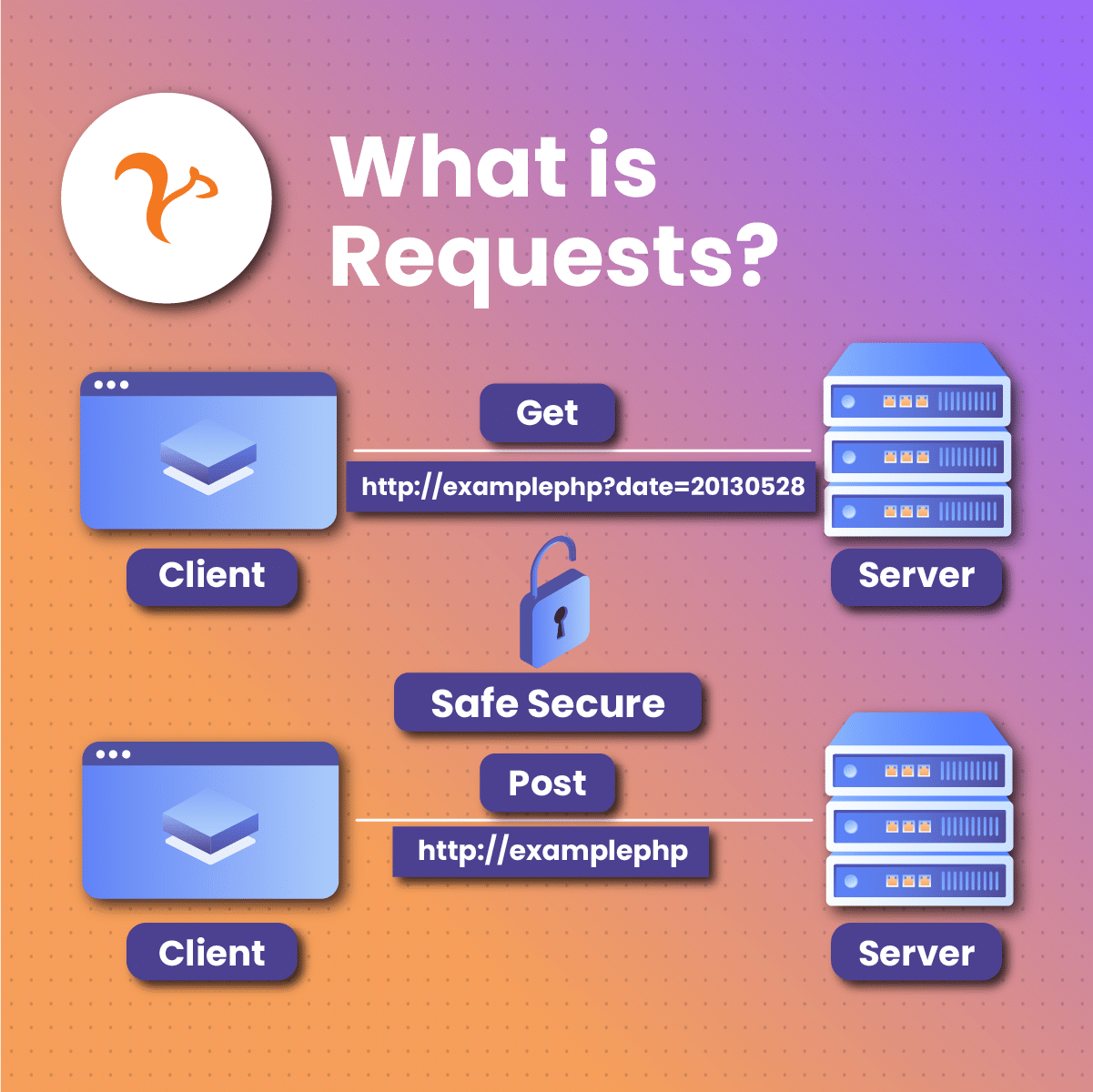As a Python developer, you might be very familiar with using requests to make HTTP requests to several APIs, servers, or web applications. However, there is a new kid on the block: the httpx request library that offers similar features and functionality as requests but with some icing on the cake. The httpx is a modern HTTP Python client. So, if you have been wondering which of these two request libraries is best for interacting with APIs, scraping the web, or downloading files, this post is for you.
We have curated all you need to know about httpx vs requests, what they are, their features, similarities, differences, pros, and cons to help you make a more informed choice for your project.
Sounds good?
Let’s dive right in. But before then, let’s do some bookkeeping.
What Are Python HTTP Request Libraries?
Python HTTP Request Libraries are the standard modules for sending and receiving HTTP requests in Python. Python HTTP request libraries are tools that allow developers to send HTTP requests to servers and receive responses within their Python applications. These libraries abstract the complexities of making HTTP requests, providing a simple interface for interacting with web services, APIs, and websites. When sending or receiving any type of request over HTTP in Python, the go-to library is the Python HTTP Request Library. These libraries help you interact with APIs and web services. This post focuses on two libraries: the httpx and the requests libraries. The debate on “httpx vs requests” has been on for a long time, and now is the excellent time to settle it once and for all.
These libraries typically support a wide range of HTTP methods, including GET, POST, PUT, DELETE, and more, enabling developers to perform various operations on web resources. They also handle common tasks such as managing headers, handling cookies, and processing JSON data, making it easier to integrate web functionality into Python applications. Popular examples of these libraries include requests and httpx, each offering unique features and capabilities that cater to different use cases and performance requirements.
What Is Httpx?
The Httpx is one of the Python HTTP libraries used for sending and receiving HTTP requests. It was designed to be a more flexible and powerful alternative to traditional HTTP request libraries, such as requests. One of the standout features of httpx is its ability to handle asynchronous requests natively, making it ideal for applications that require high concurrency or need to perform multiple HTTP requests simultaneously without blocking the main thread. It is built to be efficient and fast, offering a wide range of features that make it suitable for web service functions such as API consumption, web scraping, etc. The Httpx is among Python’s request libraries that support HTTP/1.1 and HTTP/2. It became helpful with the advent of new functionality like the asynchronous requests that the preexisting Requests library could not handle. The following are some of the features of httpx.
In addition to its asynchronous capabilities, httpx offers a robust set of features, including HTTP/2 support, connection pooling, and customizable timeout settings. It also provides built-in tools for handling authentication, redirects, and proxies, making it a comprehensive solution for developers who need a versatile HTTP client.
httpx is particularly useful in scenarios where performance is critical, such as in web scraping, API integration, and microservices communication. By leveraging the power of asynchronous I/O, httpx allows developers to build more responsive and efficient applications that can handle a large number of concurrent requests with ease.
Features Of Httpx
Httpx is a fully functional Python 3 client library. Httpx has the following features.
HTTP/1.1 and HTTP/2 Support
This httpx feature allows you to interact with multiple web servers. This function delivers more enhanced performance and efficient transport.
Asynchronous Requests
This is one of the most crucial features of httpx and is also one of the main reasons for the “httpx vs requests” debate. It allows you to execute multiple HTTP requests simultaneously using the async and awaits keywords. This feature is convenient when transferring multiple data simultaneously to prevent lagging.
Automatic Decoding
This feature will enable you to decode JSON files, making handling complex data and responses easy. This can help Python programmers save a lot of time and effort.
Integrated Command Line Support
This means you can use httpx from the command line by installing the pip install httpx. This allows you to send requests and receive feedback via the httpx command.
Direct Request To WSGI And ASGI Applications
This feature lets you send requests directly to ASGI or WSGI applications. It is beneficial when testing, allowing you to send requests to your web applications without running the server.
WSGI is an abbreviation for Web Server Gateway Interface, and ASGI means Asynchronous Server Gateway Interface. Both ASGI and WSGI differ in how they handle requests. While WSGI handles one request at a time, ASGI can handle multiple requests simultaneously.
What Are Requests?
The requests library is the commonly used Python library for sending and receiving HTTP requests, of course, before the advent of the httpx. It provides a straightforward interface for sending HTTP requests and handling responses, making it accessible to both beginners and experienced developers. With requests, you can easily perform operations like sending GET and POST requests, managing headers and cookies, and working with different content types such as JSON and XML. It is simple and elegant to use. It helps you communicate with web services and can handle many HTTP applications. However, unlike the httpx, requests do not support newer features like asynchronous programming, the current most coveted part of programming.
One of the key strengths of requests is its simplicity. The library abstracts many of the complexities of making HTTP requests, allowing developers to focus on writing clean and readable code. This has made requests a go-to choice for many Python developers when building applications that interact with web services and APIs.
While requests is primarily designed for synchronous programming, it is highly reliable and has been battle-tested in a wide range of applications, from simple scripts to large-scale web services. Its extensive documentation and active community support make it a dependable tool for developers who need a solid HTTP client without the need for advanced features like asynchronous I/O.
Key Features Of Requests
As we forge ahead in this httpx vs requests comparison article, we would like to explore some of the core features of the Python HTTP request library.
Session Handling
This feature allows you to manage sessions across several requests. This helps you reuse the same headers, TCP, cookies, etc between requests. As earlier hinted, this can help you write simple codes and make your HTTP requests more efficient.
Cookie Handling
With this feature, requests can help you handle cookies automatically. This means you can efficiently manage data between sessions using the RequestCookieJar object.
Redirection Handling
This feature gives developers many options and control over their requests. This feature can also handle automatic and manual redirection.
Multipart File Uploads
It lets you send multiple data using one request protocol. This feature helps simplify accessing and requesting files and the time spent. It is very effective when more complex structures require several files or data packets to move.
Httpx vs Requests: What Are The Similarities?
Some of the following are the similarities between httpx and requests.
- Both offer a user-friendly interface for sending and receiving requests.
- They support HTTP request methods
- They both support multipart file uploads
- They support automatic response content encoding and decoding
Httpx vs Requests: What Are The Differences?
The most common difference between requests and httpx is how they handle asynchronous requests, User-Agent, and SSL cipher suites.
Let us consider these differences more closely.
Async Support
This is the most significant difference between httpx and requests. Httpx has asynchronous programming support referred to as the asyncio library. This lets it make non-blocking HTTP requests. This feature is phenomenal because it has led to extensive performance improvement and is excellent for handling multiple requests simultaneously.
On the other hand, requests do not have an asynchronous feature. Developers looking to integrate asynchronous support with requests have to use another library or tweaks, and these methods can be more complex.
Http/2 Support
HTTP/2 is a more recent version of the HTTP Protocol and offers more improved and efficient server interactions. Httpx supports both HTTP/1.1 and the HTTP/2 protocols, bringing a mix of enhanced performance and security to the table.
In contrast, requests can only work with HTTP/1.1. For most servers or APIs today that use HTTP/2, httpx will be a better option.
For most developers, you can’t afford to treat your security issue as a light thing; aside from using a more secure protocol like HTTP/2, you can opt-in for Static Residential Proxies or Mobile Proxies to ensure all-around security on the net.
Request And Response Streaming
This feature allows you to work better with streaming APIs or large files. Httpx works well with request and response streaming, but although requests support streaming, it has limited resources and implementation that might make it ideal for some use cases.
User-Agent Handling
The difference in httpx vs requests in user-agent lies in how both libraries handle it. While httpx identifies itself as httpx, requests use a default user-agent header. This helps it identify itself as a Python requests library. The user-agent header may be blocked or treated differently depending on the server.
SSL Cipher Suites
Without discussing SSL Cipher Suites, the httpx vs requests comparison wouldn’t be complete. While httpx does not have issues with implementing SSL Cipher Suites, requests do have the issue of some SSL Cipher Suites not working. This error can lead to several problems that may affect the interaction between a server and web service applications or APIs.
Connection Pooling And Keeping Alive
Although requests and httpx supports connection pooling and keeping-alive, httpx has a better-improved connection management that can take on multiple connections simultaneously. This is key when the developer is working async requests or sending numerous requests in a short timeframe.
API
Although both libraries have very similar APIs, slight differences exist in their function signatures and behaviour. When choosing between httpx vs request, you must test your code before and while migrating from one request library to the other.
Httpx vs Requests: Pros & Cons
Understanding the pros and cons between these two libraries will help you make more guided decisions while choosing them.
Pros Of Httpx
- Its support for asynchronous requests is the most valuable benefit of using the httpx request protocol, as it can boost the performance between servers when handling multiple requests simultaneously.
- Httpx’s support for HTTP/1.1 and HTTP/2 has made it one of Python’s choice libraries for HTTP requests.
- The WSGI/ASGI applications are beneficial when testing web applications without a server.
Cons Of Httpx
- Although httpx is gaining popularity because of its exciting features, it is still in its cradle and hence needs to have the mastery that requests have been around the scene for a long time. This means that httpx may cave in if subjected to more robust complex structures.
- Since httpx is still new on the scene, it needs robust community support or an extensive catalogue of resources. A shortage of resources means fewer tutorials, resources, and solutions in case of troubleshooting.
Pros Of Requests
- Requests have the advantage of time. It has been around long enough to build a mature, extensive library with robust community support. This has made it widely used, tested, and trusted in various environments.
- Requests is simple to use and has an intuitive API. It prioritises usability for human beings, making it an excellent option for newbies.
- Although requests are relatively simplistic in operation, it still has excellent features like automatic redirection, session and cookie handling, and multipart file and data uploads.
Cons Of Request
- It does not support asynchronous requests, making it slow when executing concurrent HTTP requests.
- It does not support HTTP/2; thus, it lacks the security and performance perks of HTTP/2. Stay safe on the internet using Rotating Residential Proxies if you do not want to use a more secure protocol like httpx.
Httpx vs Requests Performance Comparison
Remember that at the core of both libraries, the choice of any developer will be hinged on how well both libraries operate and what efficiency is like. Let’s look at the performance of httpx vs requests.
Testing The Performance Of Requests And Httpx
In this httpx vs requests comparison, to test the performance of httpx and requests, you can run several HTTP requests and calculate the response time. Python has a time module that can monitor the before and after time of the execution request. Then, you can proceed to calculate the difference between them.
Performance Test Results
All things being equal, httpx works better when multiple requests are concurrent. Since httpx can handle more than one request at the same time, it means it saves time and is efficient.
Httpx Vs Requests Use Cases
Aside from the already discussed features and differences, the specific task the developer has in mind can influence the developer’s choice between httpx vs requests. So, neither of them is essentially “more” preferable.
When Should You Use Httpx?
Use httpx if you are executing several HTTP requests simultaneously. You should also use it when interacting with a server with HTTP/2 services.
When Should You Use Requests?
Use requests to execute simple synchronous requests, especially if the server you interact with needs HTTP/2 support. Beginners trying their hands out on new waters will find requests more beneficial.
Httpx Vs Requests: Which Should You Use?
Httpx vs requests are both excellent libraries for sending and receiving HTTP requests. The choice of what library to adopt depends mainly on the developer and what he wants to achieve.
But generally, you should use requests if you need a straightforward library for HTTP requests. The httpx is best used for advanced features such as downloads and streaming uploads. Also, if you are having performance issues, use httpx, as it is faster and has the asynchronous request feature for concurrent requests. Additionally, you can use US Residential Proxies or ISP Proxies for an ultrafast speed while surfing the net.
Httpx vs Request: How to Handle Errors
Every developer knows that errors and bugs are an unavoidable part of coding. A good understanding of how these two different libraries handle their errors might influence your decision on which to choose.
Httpx Errors and How to Fix Them
When errors occur in httpx, there are several exceptions that it raises. Some errors like ReadTimeout and ConnectTimeout are two of the most popular httpx errors when establishing a network connection. You must increase the timeout limit or use retries to fix this error. Also, you may get a HTTPStatusError when you receive a non-2xx HTTP response. You can fix this by decoding the error response and checking your code for the necessary changes.
Requests Errors and How to Fix Them
Like httpx, the request library also throws some exceptions. When there is a network issue, you get the ConnectionError Timeout when the request has been delayed to get feedback. The HTTPError is returned when there are issues with the HTTP response. Just like httpx, you must engage retries as often as possible to fix these errors, examining the response codes and adjusting timeouts.
Httpx vs Requests: FAQ
What Is The Main Difference Between Httpx And Requests?
Httpx is a Python 3 fully-featured HTTP client that offers asynchronous and synchronous APIs. On the other hand, Requests is an easy-to-use, user-friendly library that handles most HTTP applications.
The main difference between the httpx and requests is how they handle asynchronous requests, user-agent, and SSL cipher suites. In essence, httpx supports the asynchronous request, while requests do not.
How Do I Use Httpx In My Python Code
The httpx library is a great Python tool. To use it, you must install it and use it to get data from websites. To install it, use the pip utility:
$ python -m pip install httpx –user
After installation, you must import it into Python script to use it. Then, you can fetch data from any web address using the .get function.
Import httpx
result = httpx.get(“https://httpbin.org/get?hello=world”)
result.json()[“args”]
Your output should look this way:
{‘hello’: ‘world’}
How Do I Transit From Requests To Httpx?
This is a very straightforward process. Both httpx and requests have a similar library, so you are already used to how these things work. The main change in transitioning from httpx to request is to switch to asynchronous operations and requests.
To help your transition and make it smooth, you must begin by changing the import statement. Next, you must carefully and slowly modify the code so that it can handle asynchronous requests. It is essential to know how error works so that you can take any that might come up during your transition.
Final Thoughts on Using Httpx or Requests
The “httpx vs requests” debate will not cease, mainly depending on the developer’s or user’s choice and specific needs. The two libraries are great and are still hot picks any day. Each has its weaknesses and strengths. If you are a developer looking for performance above troubleshooting resources, then httpx is the best option; however, if you are concerned about good community support, requests is the best option.
Do you like this content? You can read more interesting topics here.









